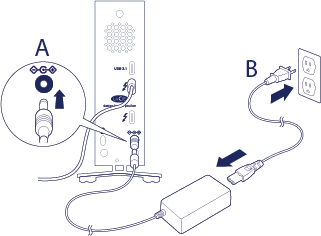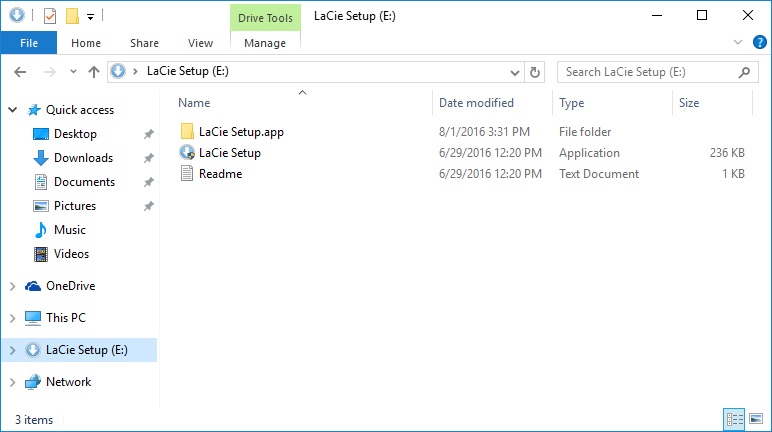Was this content helpful?
How could we make this article more helpful?
Getting Connected
Follow the setup steps in the order they are given to ensure that your LaCie hard drive's volume mounts correctly on your computer.
Macs and Thunderbolt 3
The Thunderbolt 3 connection can be used on a Mac with a Thunderbolt 3 port to reach transfer rates up to 40Gb/s bi-directional.
Using the Thunderbolt 3 connection with first or second generation Thunderbolt ports requires an adapter (sold separately) and will result in lower transfer rates (20Gb/s bi-directional for Thunderbolt 2 ports, and 10Gb/s bi-directional for first generation Thunderbolt ports).
Windows and Thunderbolt 3
Your LaCie Thunderbolt 3 storage device is certified for use with Windows PCs that have a Thunderbolt 3 port. However, you may experience connectivity issues between the storage device and the Thunderbolt 3 port on a Windows PC. Therefore, before setting up your LaCie Thunderbolt 3 storage device, please visit your PC manufacturer’s website to update your Windows PC to the latest versions of:
- BIOS
- Thunderbolt 3 firmware
- Thunderbolt 3 driver
Make certain that your PC has the most recent version of Windows 10. For questions regarding your PC, please contact the PC manufacturer. You can also review the following website for additional information: https://thunderbolttechnology.net/updates.
This issue pertains to the Thunderbolt 3 port and does not affect USB ports.
Step 1 - Connect the interface cable
Connect the interface cable from the LaCie d2 to the computer.
- USB 3.1 (USB-C) to USB-C

- Thunderbolt 3 to Thunderbolt

- USB 3.1 (USB-C) to USB-A (USB 3.0 & 2.0)

Step 2 - Connect the power supply

Connect the power supply in the following order:
- The power input port on the back of the LaCie d2.
- A live power outlet.
The LaCie d2 will power on automatically when it is connected to a computer that is turned on and a live power outlet.
Step 3 - Launch LaCie Setup Assistant
LaCie Setup Assistant (LSA) must be launched before using your drive. It will allow you to:
-
Easily format the hard drive according to your needs
-
Copy the User Manual to your computer
-
Install software for added features
-
Register your LaCie device
Launch LaCie Setup Assistant - Windows
AutoPlay: Windows AutoPlay may detect your LaCie hard drive as soon as it is connected to your computer. If the AutoPlay window appears, choose Open folder to view files and double-click LaCie Setup.

Manual access: Open the LACIE SETUP volume in Computer (My Computer for Windows XP) and double-click LaCie Setup.

LaCie Setup Assistant - Mac
Setup
LaCie Setup Assistant does not prevent you from using your computer's native disk utility program to format or partition your LaCie drive. Simply follow the Setup Assistant through completion, then use Disk Management for Windows or Disk Utility for Mac to reformat your drive.
- Select your language.
- Read the license agreement before choosing Next. Selecting Next confirms that you accept the license agreement.
- Use the slider to partition your LaCie hard drive. There are two options for partitions:
- LaCie Share: formatted as FAT32 for compatibility with Windows and Mac.
- LaCie: formatted for your operating system, NTFS for Windows or HFS+ for Mac.
- A prompt alerts you that the disk will be formatted. Select Yes to continue. LaCie Setup Assistant formats the hard drive.
- Register your LaCie device.
- Choose the software utilities that you want to install. Certain software utilities may begin to install before LaCie Setup Assistant has finished. Follow the software utility installer before completing LaCie Setup Assistant. If you do not install software utilities during this step, you can return to LaCie Setup Assistant at any time.
- LaCie Setup Assistant provides a summary of the installation. Choose Finish to close the program.
To install software utilities after the initial installation, you can run LaCie Setup Assistant again. Since the format is complete you are only prompted to choose software utilities. LaCie Setup Assistant is available on:
- LaCie Share: if you created two partitions
- LaCie: if you created one partition
Disconnecting the hard drive
In order to avoid file system corruption, it is important to unmount your hard drive’s volumes before disconnecting the interface cable. See Unmounting Your Hard Drive for details.
